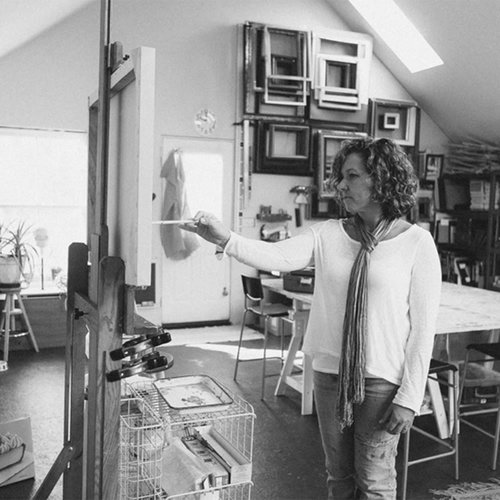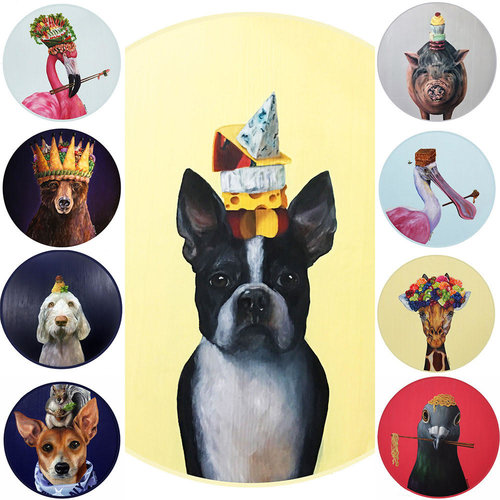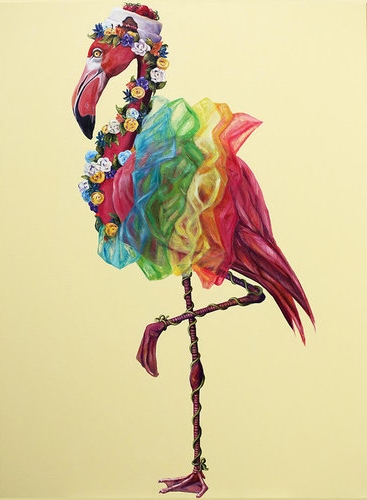by Carolyn Edlund
Artist JJ Galloway developed a lucrative business licensing her work. We spoke about getting organized and being ready to take on big opportunities and achieve success.

Licensed artist JJ Galloway works in her studio.
AS: Why did you decide to start licensing your art and how did you get started?
JG: Early in my career I realized that original art sales alone weren’t going to be enough to pay the bills. That meant finding other ways of adding income, and regarding my art as a small business and not a hobby. I needed to find a way to make my art work harder for me. Licensing looked like a great option.
To get started, I found several artists that were successful at licensing. I wanted to see what they were working on, what projects they found success in, and who they partnered with. My intention wasn’t to copy them but to learn from them.
I attended licensing trade shows and seminars. I poured through blogs and online classes. There was a lot of groundwork involved in the beginning, but it was well worth it. I not only figured what I needed to do to get started, I began making contacts and quickly found myself on the art licensing path.
AS: You’ve landed a licensing deal with a major chain. How did that happen?
JG: One of the first licensing seminars I attended was given by a buyer who bluntly explained what she did and didn’t want to see from artists. She said, “Don’t come to me:
- If you’re not prepared to give me a professional, organized pitch
- If you don’t have more than 100 pieces in your portfolio
- If you don’t know how to read a contract
- If you aren’t flexible and can’t turn things around quickly
- If you don’t have high resolution images of all your work”
This was just a small taste of what she covered. Needless to say, I was floored. I had none of these things. However, it was a good wake-up call, and now I knew what I needed to do.
It was heeding her advice that helped me land a deal with a major chain. I knew what questions to ask to make sure I was clear on what the buyer needed. Then I was able to quickly pull together a professional presentation giving them exactly what they asked for. I got my foot in the door and was able to make the most of the opportunity. They wanted to license 50 images. I showed them twice as many images, styled into five different boards that I knew filled their branding needs. I made it easy for them to work with me. Four months after the first contract, we added a second batch of art.

Galloway’s whimsical animal portraits are presented as a collection.
AS: How do you stay prepared so that you can take advantage of opportunities?
JG: Being organized is critical in licensing. My portfolio now has more than 500 images. I need to be able to access those images and all the information about the images as quickly as possible. When opportunity knocks, I’m always ready to make a pitch.
I also need to be very careful to not license images to more than one client at a time. I keep track of everything in an archive program. There are many types of art archiving programs on the market, and it’s important that you find one that fits your needs. I use ArtWork Archive because it helps me keep track of both my original art which is scattered in shows around the country and my licensing images. Depending on the landscape of your business, you’ll need to find an archive program that suits you.
Clutter is the death of creativity and a disorganized business wastes time and money. Think of your art career as a hamster wheel. If the wheel is on its side, you’ll keep running around in circles inside the wheel making little progress. If you tip the wheel up, all you need to do is feed the bottom of the wheel to keep it spinning. That’s what a good art licensing business looks like.
AS: How do you plan your activities and schedule in order to make the best use of your time to reach business goals?
JG: I once got a great piece of business advice from a coworker. She said with every new job, pick three goals you want to get from that job. Once you accomplish those goals, take some time to reflect on where you are and decide if you want to keep the job and pick three more or move on to something new.
The point of doing this exercise is to keep you focused and moving forward. At the start of each new year, I reflect on and set my new goals for the year. I call them my blue sky ideas. (I learned this concept from a Disney Imagineer.) These goals are things that I would consider ridiculously amazing to achieve, and they become my long-term goals. I take each of those goals and back them up into steps or hurdles to see how they can be achieved.Those become my short-term goals, and I start ticking off those steps one at a time. Every business decision I make on a day to day basis should contribute to one of my blue sky goals, down to my weekly schedule and to-do list.
On a daily basis, I compartmentalize my hours carefully and keep a schedule. I have administration hours, painting hours and personal hours. I’m a mother and an artist, so this is critical. I don’t want to be half available to my family and only half concentrated when I’m painting. There are some weeks where I spend more time in the studio than in the house and vice versa. And some weeks when I need to do more administration and teaching work rather than time at my easel. I keep it flexible. But when I’m painting, I’m painting…when I’m teaching, I’m teaching…and when I’m parenting, I’m parenting.

Galloway’s original painting “Rainbow Brite” oil on canvas, 48″ x 36″
AS: What is your best advice for artists who know they need this type of organization in their business, but aren’t sure how to get started?
JG: Artists who are organized in their business will ultimately be happier and more successful if they prepare a strong foundation. Why? Because people who partner with you all need the same basic information. You only have to agonize over setting it up once rather than recreating it over and over.
Artists eventually will need the following in the foundation of their business:
- a website
- a logo or some sort of identifying signature
- cards
- a bio and artist statement
- a resume
You also will need:
- photos of yourself in your studio and head shots
- photos of your work
- a social media presence (mainly Facebook and/or Instagram)
- an archive program
- a mailing list database
Don’t panic; this doesn’t all have to happen overnight. Take one thing at time and tackle it! Once it’s done, you will only have to make minor tweaks here and there as needed. There is no traditional job description for professional artist. We all wear several different hats in our profession. Licensing is just one more creative option for your business.



Excellent article with very relevant points made. Glad I took the time to read it on your recent email. Thank you
Thank you for sharing all of this excellent information! Your work is fabulous.
I have all of your foundational bullet points covered & all but the last of your “also needs”. Where I lack is the organization. It’s great to hear of your success & this certainly emphasises exactly where my energy needs to be concentrated going into 2020.
Happy new year & best of luck going forward!
This is very helpful. We are thinking of licensing some of our images, so every word of advice from someone who has done this is really helpful. Thank you for sharing.
There are different opportunities within art licensing that artists can take advantage of, including design for products as well as licensing fine art for home decor. We have additional articles on the licensing business available right here on Artsy Shark. Visit this link to view them https://www.artsyshark.com/tag/licensing/
Thank you for this excellent article. So many great insights for those of us trying to hurdle the business of becoming a financially successful artist. As a mother of three juggling many things while launching my art business I loved your advice about chunking down the day! Saving this article for certain! Thank you!
Thank you all for your kind comments. Please feel free to give me a shout with any further questions and I’ll do my best to answer them.
As Carolyn noted, Artsy Shark has a lot of great info. at the link posted above.
My email is [email protected].
Great advice and well-written article. Thank you.
Thanks for the great article. I’ve already got the foundations of a business underway which is great to acknowledge
Just need to find the right people to license with!